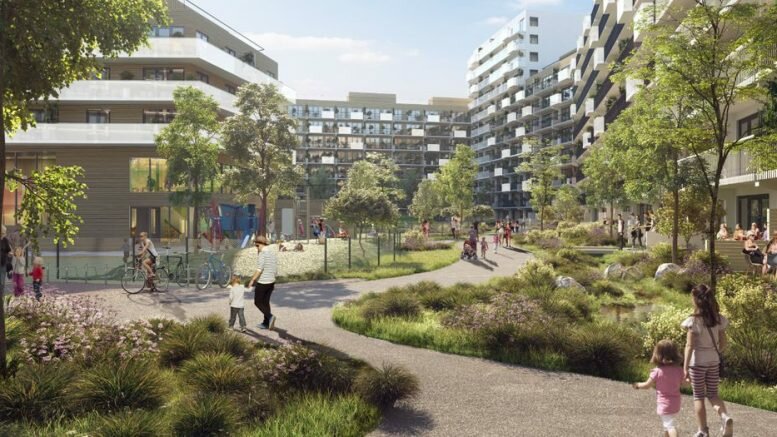OBOS Apartment at NOK 51,000 per square meter
OBOS launches innovative pricing model to make it possible to get into the housing market.
It is becoming increasingly difficult to get into the housing market for people without the opportunity to acquire the necessary equity. Now, OBOS is launching a unique concept in the Ulven district of Oslo, which will assist more members to obtain good living conditions. With OBOS Bostart (Housing Start), the housing co-operative will help reduce the growing gap in the housing market.
How does Bostart work?
Buyers of the apartments in Ulven can choose between two price options. An ordinary price, or a particularly favourable price through OBOS Bostart. Prices in OBOS Bostart are 10-15 per cent below the normal price level. The property is sold at a lower price against OBOS being entitled to buy it back if the owner wishes to sell at a later point in time. OBOS pays a price that is equal to what the buyer has bought the property for, adjusted for changes in the property price index by Property Norway (Eiendom Norge).
The scheme initially applies to the first 141 homes being built at Ulven, but if the scheme is a success, it will be applicable to other coming projects. In order to prevent anyone from gaining a “lucky” profit and to counteract speculation, OBOS will file the right to buy the apartment back.
– OBOS Bostart is a unique pilot project and an honest attempt to help more people into the housing market. This will help to fulfill our goal of providing more members with a good home, says CEO in OBOS, Daniel Kjørberg Siraj.
Innovative business cooperation
Buyers wishing to obtain the property without the restriction contained in OBOS Bostart, can choose to buy housing at regular prices.
– Here too we have placed emphasis on reducing the threshold to enter the housing market. In the Ulvenparken housing co-ownership, the first apartments are priced around 20 per cent lower than housing in corresponding projects in the area, says CEO Daniel Kjørberg Siraj. This has become possible thanks to favourable land prices, innovative and thorough planning and close co-operation between the various businesses involved – such as architect, entrepreneur and consultants.
– Together with OBOS Bostart, this provides a rare opportunity to acquire a favourable entrance ticket to the housing market in Oslo, says Siraj.
What happens when house prices fluctuate?
The right of buying the apartment back entails that if the owner wishes to sell the apartment at any point in time, OBOS has the right to buy it back at the original price plus a percentage appreciation of the corresponding price increase for apartments in the Oslo area – based on the housing price index by Eiendom Norge.
This means that the buyer will get a value increase on his apartment, which will be percentage-wise the same as for the average of apartments in Oslo.
Should housing prices fall, the property price index from Property Norway will be negative and the purchase price from OBOS will be lowered accordingly. If the market price has fallen, co-operative share holder may incur losses on par with others.
- Average price with regular price: NOK 60,384 / m2
- Average price with Bostart: NOK 51,326 / m2
Examples of 2, 3, 4 and 5 bedroom apartments
| Apartment type | Ord. price | OBOS Bostart | Rebate |
| 1-room: 36 m2 | 2 050 000 | 1 742 500 | 85 % |
| 2-rooms: 42 m2 | 2 520 000 | 2 142 000 | 85 % |
| 3-rooms: 63 m2 | 4 000 000 | 3 400 000 | 85 % |
| 4-rooms: 68 m2 | 3 960 000 | 3 366 000 | 85 % |
| 4-rooms : 81 m2 | 4 870 000 | 4 139 500 | 85 % |
| 5-rooms: 92 m2 | 5 620 000 | 4 777 000 | 85 % |
Here we have chosen average apartments. That is, there are cheaper apartments of each type available as well.
About OBOS
From modest beginnings in 1929, OBOS has become the largest Nordic cooperative building association. Today OBOS is owned by its more than 415 000 members, most of them in the Oslo-area.
In recent years, OBOS has set up regional offices in several of Norway’s biggest cities, and it is now in the process of becoming a nationwide housing organisation.
The company’s objectives through all these years have been to make housing available to members – and to manage housing cooperatives and condominium associations.
OBOS was founded on the principles that members should contribute through savings, housing should be offered to members at cost, down payments should be covered by contributions from each individual member; and that housing should be of ordinary but good standard with modern fittings.
Wanted to improve housing conditions
In the 1920s, Oslo experienced a major housing shortage. In 1929, following the lead of Swedish construction workers who had formed a savings company to acquire housing, members of the Oslo construction workers’ union formed what was to become OBOS – Oslo Bolig og Sparelag (Oslo Housing and Savings Society).
Its purpose was to improve city housing conditions and to ensure continuous production of housing through a members’ organization, as opposed to public housing construction.
A driving force for housing development
From 1935, OBOS cooperated with the municipality of Oslo, and after the Second World War it became a driving force for housing development in Oslo. The municipality provided vacant sites at a reasonable price, and, in return bought a quarter of the completed housing projects for that are in the greatest need.
In 1946, the Norwegian State Housing Bank (Husbanken) was founded, which, for most people, made buying their own home possible for the first time, and led to large scale housing construction. Between 1950 and 1960, OBOS developed projects with around 20,000 homes – the largest number in any decade.
Has built more than 100 000 homes
To date, OBOS has built more than 100 000 homes, most of them in the Oslo area – representing a quarter of Oslo’s housing stock. Initially, mostly apartment blocks were built, but more recently the proportion of small, detached and terraced houses has increased significantly.
The homes are organized into more than 400 associated cooperatives managed by OBOS, which also offers services, maintenance and renovation.
Manages over 215 000 homes
In total, the OBOS Group manages over 215 000 homes and apartments. Of these, more than 75 000 are located in housing co-operatives affiliated with the group. The OBOS Group includes 20 wholly-owned subsidiaries, employing more than 2 300 people.
Buying and selling homes
We sell new homes through our real estate company “OBOS Eiendomsmeglere”. Second-hand homes in OBOS-affiliated housing cooperatives are sold through either this company or through other external estate agents.
Exposed to the free marked
OBOS’ role has changed since the Norwegian housing market was deregulated in the 1980s. From being a body that carried out public housing policy, the organization today is now exposed to competition and works under the same basic conditions as the rest of Norwegian business and industry.
Many advantages for the members
OBOS is now investing considerable sums in vacant sites and housing projects. It is leveraging its financial strength and market dominance to negotiate on behalf of its members. OBOS works to offer them advantages, such as cheaper electricity, insurance, telecommunications, petrol, cable TV – as well as good offers on cultural happenings and home products.
In addition, our members have access to more than 90 000 homes in a large and varied second-hand housing market.
© OBOS / #Norway Today





